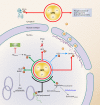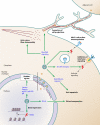Viral serine/threonine protein kinases
- PMID: 21084474
- PMCID: PMC3020496
- DOI: 10.1128/JVI.01369-10
Viral serine/threonine protein kinases
Abstract
Phosphorylation represents one the most abundant and important posttranslational modifications of proteins, including viral proteins. Virus-encoded serine/threonine protein kinases appear to be a feature that is unique to large DNA viruses. Although the importance of these kinases for virus replication in cell culture is variable, they invariably play important roles in virus virulence. The current review provides an overview of the different viral serine/threonine protein kinases of several large DNA viruses and discusses their function, importance, and potential as antiviral drug targets.
Figures



Similar articles
-
Phosphoregulation of a Conserved Herpesvirus Tegument Protein by a Virally Encoded Protein Kinase in Viral Pathogenicity and Potential Linkage between Its Evolution and Viral Phylogeny.J Virol. 2020 Aug 31;94(18):e01055-20. doi: 10.1128/JVI.01055-20. Print 2020 Aug 31. J Virol. 2020. PMID: 32611749 Free PMC article.
-
Characterization of a Herpes Simplex Virus 1 (HSV-1) Chimera in Which the Us3 Protein Kinase Gene Is Replaced with the HSV-2 Us3 Gene.J Virol. 2015 Oct 21;90(1):457-73. doi: 10.1128/JVI.02376-15. Print 2016 Jan 1. J Virol. 2015. PMID: 26491159 Free PMC article.
-
The Vaccinia Virus B12 Pseudokinase Represses Viral Replication via Interaction with the Cellular Kinase VRK1 and Activation of the Antiviral Effector BAF.J Virol. 2021 Jan 13;95(3):e02114-20. doi: 10.1128/JVI.02114-20. Print 2021 Jan 13. J Virol. 2021. PMID: 33177193 Free PMC article.
-
Keep it in the subfamily: the conserved alphaherpesvirus US3 protein kinase.J Gen Virol. 2011 Jan;92(Pt 1):18-30. doi: 10.1099/vir.0.025593-0. Epub 2010 Oct 13. J Gen Virol. 2011. PMID: 20943887 Review.
-
Us3 Protein Kinase Encoded by HSV: The Precise Function and Mechanism on Viral Life Cycle.Adv Exp Med Biol. 2018;1045:45-62. doi: 10.1007/978-981-10-7230-7_3. Adv Exp Med Biol. 2018. PMID: 29896662 Review.
Cited by
-
Discovery of a Coregulatory Interaction between Kaposi's Sarcoma-Associated Herpesvirus ORF45 and the Viral Protein Kinase ORF36.J Virol. 2016 Jun 10;90(13):5953-5964. doi: 10.1128/JVI.00516-16. Print 2016 Jul 1. J Virol. 2016. PMID: 27099309 Free PMC article.
-
A virion-associated protein kinase induces apoptosis.J Virol. 2011 Dec;85(24):13144-52. doi: 10.1128/JVI.05294-11. Epub 2011 Oct 12. J Virol. 2011. PMID: 21994449 Free PMC article.
-
Role of gB and pUS3 in Equine Herpesvirus 1 Transfer between Peripheral Blood Mononuclear Cells and Endothelial Cells: a Dynamic In Vitro Model.J Virol. 2015 Dec;89(23):11899-908. doi: 10.1128/JVI.01809-15. Epub 2015 Sep 16. J Virol. 2015. PMID: 26378176 Free PMC article.
-
Deciphering the complete human-monkeypox virus interactome: Identifying immune responses and potential drug targets.Front Immunol. 2023 Mar 27;14:1116988. doi: 10.3389/fimmu.2023.1116988. eCollection 2023. Front Immunol. 2023. PMID: 37051239 Free PMC article.
-
Potential Phosphorylation of Viral Nonstructural Protein 1 in Dengue Virus Infection.Viruses. 2021 Jul 17;13(7):1393. doi: 10.3390/v13071393. Viruses. 2021. PMID: 34372598 Free PMC article.
References
-
- Advani, S. J., R. Brandimarti, R. R. Weichselbaum, and B. Roizman. 2000. The disappearance of cyclins A and B and the increase in activity of the G(2)/M-phase cellular kinase cdc2 in herpes simplex virus 1-infected cells require expression of the alpha22/U(S)1.5 and U(L)13 viral genes. J. Virol. 74:8-15. - PMC - PubMed
-
- Andrei, G., E. De Clercq, and R. Snoeck. 2009. Drug targets in cytomegalovirus infection. Infect. Disord. Drug Targets 9:201-222. - PubMed
Publication types
MeSH terms
Substances
LinkOut - more resources
Full Text Sources

